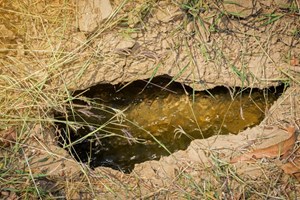California achieves record groundwater recharge in 2023
Sacramento, Calif. (UI) – The California Department of Water Resources (DWR) has released the latest Semi-Annual Groundwater Conditions report, revealing that Water Year 2023 achieved 4.1 million acre-feet of managed groundwater recharge, nearly matching the water storage capacity of Shasta Lake. Groundwater storage increased by 8.7 million acre-feet, marking the first reported rise since 2019.
Key findings from the report include:
- Reduction in Groundwater Pumping: A significant reduction in groundwater pumping in 2023 led to improved groundwater conditions, including a decrease in land subsidence and a rebound in ground surface elevation in some areas.
- Groundwater Sustainability Plans: For the first time, the report includes data from local groundwater sustainability agencies (GSAs) across 99 groundwater basins, covering over 90% of the state’s groundwater use.
- Groundwater’s Importance: Nearly 85% of Californians depend on groundwater for part of their water supply. In dry years, communities rely heavily on groundwater to meet the needs of households, agriculture, and businesses. California’s ecosystems also depend on groundwater.
Despite the positive news, long-term groundwater storage remains in a deficit of nearly 40 million acre-feet over the past two decades due to over-pumping. To address this, California needs to expand groundwater recharge projects, upgrade water infrastructure, and modernize its water distribution system.
“California is preparing for weather extremes by maximizing wet years to store as much water as possible for dry years,” said Paul Gosselin, DWR Deputy Director of Sustainable Water Management. “The impressive recharge numbers in 2023 result from local and state efforts, but more must be done to capture and store water during wet years.”
During the 2023 Water Year, state agencies permitted over 1.2 million acre-feet of groundwater recharge, more than 400,000 acre-feet of floodwater recharge, and millions more acre-feet of managed and natural recharge. Groundwater recharge projects were critical during flood responses, diverting water from flood-prone areas to recharge basins.
Since groundwater is out of sight, data from underground aquifers are crucial for informed management decisions. DWR’s Semi-Annual Groundwater Conditions report provides current data to support the comprehensive California’s Groundwater (Bulletin 118) publication, updated every five years. These reports help state and local agencies manage groundwater resources for long-term water supply resiliency.
The Sustainable Groundwater Management Act, signed into law ten years ago, has enhanced understanding of California’s groundwater basins through data collected by local GSAs and state investments in new technologies and expanded monitoring.
The Semi-Annual Groundwater Conditions report includes the latest data on groundwater levels, storage, recharge, land subsidence, well infrastructure, and basin status. This report is an essential resource for anyone interested in understanding their local water supply and the importance of groundwater management.
Groundwater is crucial for human well-being, ecosystems, agriculture, and economies. Each year, we learn more about addressing the challenges of a changing climate, and the data in DWR’s report provide the latest understanding of this vital water resource.
Related News
From Archive

- Glenfarne Alaska LNG targets late-2026 construction start for 807-mile pipeline project
- U.S. water reuse boom to fuel $47 billion in infrastructure spending through 2035
- $2.3 billion approved to construct 236-mile Texas-to-Gulf gas pipeline
- Major water pipe break in Puerto Rico hits over 165,000 customers
- Potomac River Tunnel project enters construction phase beneath Washington, D.C.
- Pennsylvania American Water launches interactive map to identify, replace lead water service lines
- Trump's tariffs drive $33 million cost increase for Cincinnati sewer project
- Utah city launches historic $70 million tunnel project using box jacking under active rail line
- Tulsa residents warned after sewer lines damaged by boring work
- Fatal trench collapse halts sewer construction in Massachusetts; two workers hospitalized




Comments